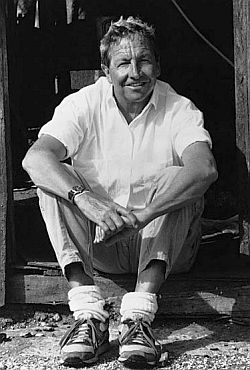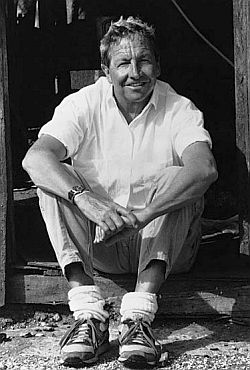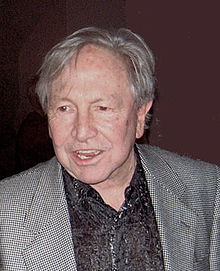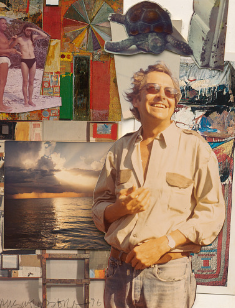Mr Rauschenberg died of heart failure , said his representative at PaceWildenstein gallery in New York.
One of his most famous works, or "combines," was "Bed," created when he woke up in the mood to paint yr had no money for a canvas. His solution was to take the quilt off his bed and use paint, toothpaste and fingernail polish for his creation.
Mr. Rauschenmberg, also a sculptor and choreographer, didn't mine popular culture wholesale, as did Andy Warhol (Campbell's Soup Cans) and Roy Lichtenstein (Comic books), but his combines -in - congruous combinations of three-dimensional objects and paint - shared pop's blurring of art and objects from modern life.
He also responded to hos pop colleagued an began incorporating up-to-the-minute photographed images in his works in the 1960s, including memorably pictures of John F. Kennedy., He won a 1984 Grammy Award for best album package for the Talking Heads' "Speaking in Tongues."
Patriot Ledger May 14, 2008
information from Domingue Descendent
His works are all over the campus of Lamar State College of Port Arthur, Texas
Artist
(1925 - 2008)
Born Milton Rauschenberg on October 22, 1925 at Gates Hospital in Port Arthur, Texas, he changed his name to Robert after WWII. Rauschenberg's grandfather was a doctor who immigrated from Berlin, Germany to Cameron, Louisiana in the 19th century. His grandmother was a Cherokee who died young from tuberculosis. His father, Ernest Rauschenberg, was forced to work as a farm laborer and as a maintenance man's helper. He later got a job at Gulf States Utilities and married Dora, a telephone operator who lived in Galveston, Texas. After their marriage, Dora cut out dress patterns for a living. "That's where I learned collage" says Rauschenberg.
Raised at 2721 17th St. in Port Arthur, his fundamentalist Christian household attended Sixth Street Church of Christ. He had no formal art training but liked to draw and copy the "funnies". He was quiet , shy and kind to others and loved animals. He also loved to dance but was not allowed because the church forbade it. In school he was active in drama. He graduated from Thomas Jefferson High School in 1943.
Rauschenberg then attended the University of Texas at Austin and studied pharmacy at his family's request. Suffering from Dyslexia, he had trouble in academics and was expelled for letting a frog escape from biology class. That same year, he was drafted into the Navy and was stationed in California serving in various medical capacities. His experiences tending to the wounded permanently turned him against war and violence. However, his first exposure to real art occurred during this period when he visited the Los Angeles County Museum and saw Gainsborough's Blue Boy and Lawrence's Pinkie.
After the war he returned to Port Arthur to discover his family had moved to Louisiana. He stayed in Port Arthur about six months before returning to Los Angeles. There he worked for a year at a swimsuit factory when a designer there took him under her wing and arranged for him to enroll at the Kansas City Art Institute. Between 1947 and 1948 he studied at the Kansas City Art Institute and Black Mountain College near Asheville, N.C., where he changed his name to Robert. There he studied art history, sculpture and music. He was also involved with window displays, executing film sets and setting up photographic studios. Then in 1948 he went to Paris to attend the Academie Julian where he met Susan Weil who later became his wife (1950-1952). He returned to Black Mountain College to study under the exiled former Bauhaus instructor, Joseph Albers. Between 1948 and 1954 he would travel back and forth from the U.S. to Europe. It was during this time he met Merce Cunningham and composer John Cage and collaborated closely with both. In 1949 he moved to New York City and studied at the Art Student's League until 1952. He did window displays for Bonwit Teller and Tiffany, and had his first one man exhibition at Betty Parsons Gallery in 1951. He met Cy Twombly there and was included in the "First Artists' Annual" featuring established Abstract Expressionists such as Jackson Pollock, Franz Kline, and Robert Motherwell. That same year, his son Christopher was born.
In 1952 at Black Mountain with John Cage, Rauschenberg participated in the first Happening. The beginning of a long career as a performance artist. This set in motion the anti art strategies begun by the Dadaists (from 1915-1920 who tried to eliminate the distinction between low and high art) and continued with Rauschenberg and his contemporaries. They were the new generation abstract expressionists who drew from the popular culture of the world around them while using the techniques of the earlier abstract expressionists like dripping paint.
His travels took him to Italy, France and Spain. In 1953 he had exhibitions in Florence and Rome, Italy. He moved into a studio in New York that same year and started to paint his red pictures, replacing his all white and all black paintings begun in 1951. He also designed costumes for Merce Cunningham's performances in 1953. His work for Cunningham's Dance Company intensified between 1954 and 1965.
Rauschenberg met Jasper Johns in 1954 and moved to a new studio space in the same neighborhood as Johns in 1955. They worked closely together until 1962. By the mid 50's he was making the wild assemblage and collaged multimedia works for which he is best known. They are called "Combines" by the artist and possibly denote the combination of two and three dimensional space, of art and life, of many media. He executed 60 of them between 1955 and 1959. In 1959 he was represented at the Documenta "2", Kassel, and at the Paris and Sao Paulo Biennials.
In 1962 he started working in printmaking, adding the lithography and silkscreen processes to the painting, collage and affixed objects on canvas. He also did his first lithographic work, for which he was awarded the Grand Prix at Ljubljana. He was given his first retrospective exhibition in Europe at the Galerie Sonnabend, Paris in 1963 which was later shown at the Jewish Museum in New York. In that same year, he created and performed his first dance performance "Pelican". The next year he had another retrospective showing of his work at the Whitechapel Gallery, London and won the Grand Prix at the Venice Biennale. He also went on a world tour with Cage and Cunningham's Dance Company. In 1966 and 1967 he founded EAT (Experiments in Art and Technology) with scientists, helped 300 artists with special projects, created his 78" tall Revolvers, with revolving Plexiglass discs, and joined Gemini (GEL), founded by Kenneth Tyler, to work with artists on the cutting edge of technology. He was invited by NASA in 1969 to witness the lift off of Apollo 11 at Kennedy Space Center and to use this theme in his work.
Rauschenberg set up the foundation Change, Inc. for destitute artists in 1970 and a house with art studios in Florida in 1971, where he lives on Captiva Island. Artistically, he began his now-signature procedure of building visual fields from collisions of appropriated media images tossed together in the same chaotic way we are forced to process experience in this information age. In 1974 he collaborated with the writer Alain Robbe-Grillet and traveled to Israel and India. The following year he received the Honorary Degree of Fine Arts from the University of South Florida, Tampa and , together with James Rosenquist, became involved in appealing for a re-examination of taxation for non-profit making art institutions. A large retrospective of his work was shown in several American cities from 1976 to 1978 and in 1980 he had retrospectives at Berlin, Dusseldorf, Copenhagen, Frankfurt, Munich and London. In 1981 his photographs were shown at the Centre Pompidou, Paris, and he began the largest painting in the world. "1/4 Mile" or "Two Furlong Piece"is an ongoing project which was first exhibited at the Metropolitan Museum of Art in New York in 1987. He went to China in 1982 to work in the oldest paper making factory in the world. In 1983 he made the Talking Heads album design , with an edition of 50,000, for which he received a Grammy Award. He began his Rauschenberg Overseas Culture Interchange (ROCI) in 1984 "To introduce the world to itself and contribute to world-wide peace." Bring art across borders and awaken curiosity. "I though is would be terrible to live in this world and not know what another part of the world was like." says Rauschenberg. Mainly "sensitive" areas were involved in these works, Mexico, Chile, Venezuela, China, Tibet, Japan, Cuba, and USSR.
Robert Rauschenberg returned to Port Arthur in 1984 for an exhibition of his works at the Port Arthur Public Library. He also executed the Commemorative Poster. In 1985 he was named Sesquicentennial Artist to commemorate the 150th anniversary of Texas as the "state's most famous artist". In 1986, he received the Award for Excellence in International Cultural Interchange by the World Print Council, the International Center of Photography Art Award in 1987 and the Algur H. Meadows award for Exellence in the Arts in 1989.
In 1991, Port Arthur hosted "A Texas Salute to Robert Rauschenberg" at the Civic Center. At the dinner event, the State of Texas recognized Rauschenberg for his contributions to world culture. Since 1992 he has used an Iris printer to make digital color prints of his photographs. It is this technology that allows for the high-resolution images and luminous hues in his large scale works on paper "Anagrams" (1995-1997). In 1996 he transferred his Iris prints to wet plaster in his "Arcadian Retreats", a fresco series that provided him with an entirely new avenue of exploration. His 1998 retrospective in Houston consisted of so many works, it took all three of Houston's major museums (the Museum of Fine Arts, Houston, The Menil Collection and Contemporary Arts Museum) to adequately show it all. "Robert Rauschenberg: A Retrospective" began it's tour in 1997 at the Guggenheim in NYC and was also seen at the Guggenheim in Bilbao through 1999. The Port Arthur Historical Society also hosted an exhibition featuring his "Tribute 21 " series at the Museum of the Gulf Coast.
Robert Rauschenberg has been one step ahead of and influential to all the major post war art movements since Abstract Expressionism. Often categorized as a pop artist, he remains independent of any affiliation. His lifelong commitment to collaboration with performers, printmakers, engineers, writers, artists, and artisans from around the world is the manifestation of his expansive artistic philosophy. His artistic vision is a manifestation of the changing world and it's ideology as he moves through life. His "Combines" of the early ‘50's seem to have developed in response to the inundation of disparate imagery we are subject to in the 21st Century. It is only fitting that he was asked to design the cover of Time magazine's special double issue on the first anniversary of the 9/11 terrorist attack on the United States. Only Rauschenberg could sum up the vast amount of information we have received since that day in one piece of artwork.
Research information from the writings of Dr. Lynne Lokensgard, professor of Art History, Lamar University and Julia Blaut, Assistant Curator, Solomon R. Guggenheim Museum, New York.∼Renown Abstract-Expressionist artist.
Mr Rauschenberg died of heart failure , said his representative at PaceWildenstein gallery in New York.
One of his most famous works, or "combines," was "Bed," created when he woke up in the mood to paint yr had no money for a canvas. His solution was to take the quilt off his bed and use paint, toothpaste and fingernail polish for his creation.
Mr. Rauschenmberg, also a sculptor and choreographer, didn't mine popular culture wholesale, as did Andy Warhol (Campbell's Soup Cans) and Roy Lichtenstein (Comic books), but his combines -in - congruous combinations of three-dimensional objects and paint - shared pop's blurring of art and objects from modern life.
He also responded to hos pop colleagued an began incorporating up-to-the-minute photographed images in his works in the 1960s, including memorably pictures of John F. Kennedy., He won a 1984 Grammy Award for best album package for the Talking Heads' "Speaking in Tongues."
Patriot Ledger May 14, 2008
information from Domingue Descendent
His works are all over the campus of Lamar State College of Port Arthur, Texas
Artist
(1925 - 2008)
Born Milton Rauschenberg on October 22, 1925 at Gates Hospital in Port Arthur, Texas, he changed his name to Robert after WWII. Rauschenberg's grandfather was a doctor who immigrated from Berlin, Germany to Cameron, Louisiana in the 19th century. His grandmother was a Cherokee who died young from tuberculosis. His father, Ernest Rauschenberg, was forced to work as a farm laborer and as a maintenance man's helper. He later got a job at Gulf States Utilities and married Dora, a telephone operator who lived in Galveston, Texas. After their marriage, Dora cut out dress patterns for a living. "That's where I learned collage" says Rauschenberg.
Raised at 2721 17th St. in Port Arthur, his fundamentalist Christian household attended Sixth Street Church of Christ. He had no formal art training but liked to draw and copy the "funnies". He was quiet , shy and kind to others and loved animals. He also loved to dance but was not allowed because the church forbade it. In school he was active in drama. He graduated from Thomas Jefferson High School in 1943.
Rauschenberg then attended the University of Texas at Austin and studied pharmacy at his family's request. Suffering from Dyslexia, he had trouble in academics and was expelled for letting a frog escape from biology class. That same year, he was drafted into the Navy and was stationed in California serving in various medical capacities. His experiences tending to the wounded permanently turned him against war and violence. However, his first exposure to real art occurred during this period when he visited the Los Angeles County Museum and saw Gainsborough's Blue Boy and Lawrence's Pinkie.
After the war he returned to Port Arthur to discover his family had moved to Louisiana. He stayed in Port Arthur about six months before returning to Los Angeles. There he worked for a year at a swimsuit factory when a designer there took him under her wing and arranged for him to enroll at the Kansas City Art Institute. Between 1947 and 1948 he studied at the Kansas City Art Institute and Black Mountain College near Asheville, N.C., where he changed his name to Robert. There he studied art history, sculpture and music. He was also involved with window displays, executing film sets and setting up photographic studios. Then in 1948 he went to Paris to attend the Academie Julian where he met Susan Weil who later became his wife (1950-1952). He returned to Black Mountain College to study under the exiled former Bauhaus instructor, Joseph Albers. Between 1948 and 1954 he would travel back and forth from the U.S. to Europe. It was during this time he met Merce Cunningham and composer John Cage and collaborated closely with both. In 1949 he moved to New York City and studied at the Art Student's League until 1952. He did window displays for Bonwit Teller and Tiffany, and had his first one man exhibition at Betty Parsons Gallery in 1951. He met Cy Twombly there and was included in the "First Artists' Annual" featuring established Abstract Expressionists such as Jackson Pollock, Franz Kline, and Robert Motherwell. That same year, his son Christopher was born.
In 1952 at Black Mountain with John Cage, Rauschenberg participated in the first Happening. The beginning of a long career as a performance artist. This set in motion the anti art strategies begun by the Dadaists (from 1915-1920 who tried to eliminate the distinction between low and high art) and continued with Rauschenberg and his contemporaries. They were the new generation abstract expressionists who drew from the popular culture of the world around them while using the techniques of the earlier abstract expressionists like dripping paint.
His travels took him to Italy, France and Spain. In 1953 he had exhibitions in Florence and Rome, Italy. He moved into a studio in New York that same year and started to paint his red pictures, replacing his all white and all black paintings begun in 1951. He also designed costumes for Merce Cunningham's performances in 1953. His work for Cunningham's Dance Company intensified between 1954 and 1965.
Rauschenberg met Jasper Johns in 1954 and moved to a new studio space in the same neighborhood as Johns in 1955. They worked closely together until 1962. By the mid 50's he was making the wild assemblage and collaged multimedia works for which he is best known. They are called "Combines" by the artist and possibly denote the combination of two and three dimensional space, of art and life, of many media. He executed 60 of them between 1955 and 1959. In 1959 he was represented at the Documenta "2", Kassel, and at the Paris and Sao Paulo Biennials.
In 1962 he started working in printmaking, adding the lithography and silkscreen processes to the painting, collage and affixed objects on canvas. He also did his first lithographic work, for which he was awarded the Grand Prix at Ljubljana. He was given his first retrospective exhibition in Europe at the Galerie Sonnabend, Paris in 1963 which was later shown at the Jewish Museum in New York. In that same year, he created and performed his first dance performance "Pelican". The next year he had another retrospective showing of his work at the Whitechapel Gallery, London and won the Grand Prix at the Venice Biennale. He also went on a world tour with Cage and Cunningham's Dance Company. In 1966 and 1967 he founded EAT (Experiments in Art and Technology) with scientists, helped 300 artists with special projects, created his 78" tall Revolvers, with revolving Plexiglass discs, and joined Gemini (GEL), founded by Kenneth Tyler, to work with artists on the cutting edge of technology. He was invited by NASA in 1969 to witness the lift off of Apollo 11 at Kennedy Space Center and to use this theme in his work.
Rauschenberg set up the foundation Change, Inc. for destitute artists in 1970 and a house with art studios in Florida in 1971, where he lives on Captiva Island. Artistically, he began his now-signature procedure of building visual fields from collisions of appropriated media images tossed together in the same chaotic way we are forced to process experience in this information age. In 1974 he collaborated with the writer Alain Robbe-Grillet and traveled to Israel and India. The following year he received the Honorary Degree of Fine Arts from the University of South Florida, Tampa and , together with James Rosenquist, became involved in appealing for a re-examination of taxation for non-profit making art institutions. A large retrospective of his work was shown in several American cities from 1976 to 1978 and in 1980 he had retrospectives at Berlin, Dusseldorf, Copenhagen, Frankfurt, Munich and London. In 1981 his photographs were shown at the Centre Pompidou, Paris, and he began the largest painting in the world. "1/4 Mile" or "Two Furlong Piece"is an ongoing project which was first exhibited at the Metropolitan Museum of Art in New York in 1987. He went to China in 1982 to work in the oldest paper making factory in the world. In 1983 he made the Talking Heads album design , with an edition of 50,000, for which he received a Grammy Award. He began his Rauschenberg Overseas Culture Interchange (ROCI) in 1984 "To introduce the world to itself and contribute to world-wide peace." Bring art across borders and awaken curiosity. "I though is would be terrible to live in this world and not know what another part of the world was like." says Rauschenberg. Mainly "sensitive" areas were involved in these works, Mexico, Chile, Venezuela, China, Tibet, Japan, Cuba, and USSR.
Robert Rauschenberg returned to Port Arthur in 1984 for an exhibition of his works at the Port Arthur Public Library. He also executed the Commemorative Poster. In 1985 he was named Sesquicentennial Artist to commemorate the 150th anniversary of Texas as the "state's most famous artist". In 1986, he received the Award for Excellence in International Cultural Interchange by the World Print Council, the International Center of Photography Art Award in 1987 and the Algur H. Meadows award for Exellence in the Arts in 1989.
In 1991, Port Arthur hosted "A Texas Salute to Robert Rauschenberg" at the Civic Center. At the dinner event, the State of Texas recognized Rauschenberg for his contributions to world culture. Since 1992 he has used an Iris printer to make digital color prints of his photographs. It is this technology that allows for the high-resolution images and luminous hues in his large scale works on paper "Anagrams" (1995-1997). In 1996 he transferred his Iris prints to wet plaster in his "Arcadian Retreats", a fresco series that provided him with an entirely new avenue of exploration. His 1998 retrospective in Houston consisted of so many works, it took all three of Houston's major museums (the Museum of Fine Arts, Houston, The Menil Collection and Contemporary Arts Museum) to adequately show it all. "Robert Rauschenberg: A Retrospective" began it's tour in 1997 at the Guggenheim in NYC and was also seen at the Guggenheim in Bilbao through 1999. The Port Arthur Historical Society also hosted an exhibition featuring his "Tribute 21 " series at the Museum of the Gulf Coast.
Robert Rauschenberg has been one step ahead of and influential to all the major post war art movements since Abstract Expressionism. Often categorized as a pop artist, he remains independent of any affiliation. His lifelong commitment to collaboration with performers, printmakers, engineers, writers, artists, and artisans from around the world is the manifestation of his expansive artistic philosophy. His artistic vision is a manifestation of the changing world and it's ideology as he moves through life. His "Combines" of the early ‘50's seem to have developed in response to the inundation of disparate imagery we are subject to in the 21st Century. It is only fitting that he was asked to design the cover of Time magazine's special double issue on the first anniversary of the 9/11 terrorist attack on the United States. Only Rauschenberg could sum up the vast amount of information we have received since that day in one piece of artwork.
Research information from the writings of Dr. Lynne Lokensgard, professor of Art History, Lamar University and Julia Blaut, Assistant Curator, Solomon R. Guggenheim Museum, New York.∼Renown Abstract-Expressionist artist.
Family Members
Sponsored by Ancestry
Advertisement
Advertisement











